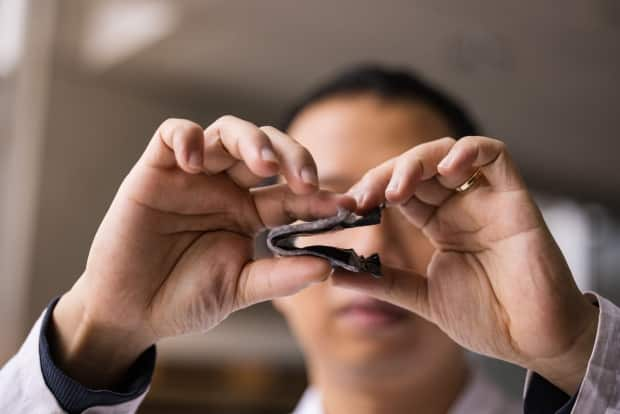UBC team creates stretchy, washable battery — and new possibilities for wearable tech

Researchers from the University of British Columbia have created what they're saying could be the first battery that is both flexible and washable.
John Madden, an electrical and computer engineering professor and director of UBC's Advanced Materials and Process Engineering Lab, says these batteries are just like alkaline batteries that we're used to, except they are rechargeable, stretchable and bendable.
"Imagine a battery that's maybe a little bit larger than a coin cell that you can grab in your hands, stretch to twice its length, twist and throw in the washing machine and it will still work," Madden told host Gloria Macarenko on CBC's On The Coast.
Madden's team, which included Dr. Ngoc Tan Nguyen, a postdoctoral fellow at UBC's faculty of applied science and PhD student Bahar Iranpour, had been working with sensor technology and needed a battery that was comfortable, safe and durable. Some of the challenges they encountered when developing this technology was finding a proper case to contain the battery fluids and then making sure the case could stretch and bend.
The team created several ultra-thin layers of plastic polymers integrated with the battery components — zinc and manganese dioxide — and wrapped inside a casing of the same polymer, all described in this paper published in the journal Advanced Energy Materials.
Zinc and manganese dioxide have an added benefit because they are safer for devices worn next to the skin, compared to lithium-ion batteries.

Once the battery was created, the team got to testing.
"We were excited to see we could throw it in the washing machine with soap and other clothes and still enough of the contents were kept separate from the wash that it will still work," said Madden, estimating that the batteries had been through between 36 and 39 wash cycles.
Although the batteries are probably a few years from being widely available or used, Madden's team is working on several product ideas.
"For example, one of our potential customers would like to put it into a heart monitor and it's a heart monitor that's worn by patients for 24 hours," he said. "That would be an application where somebody is sent home from the hospital, they can wear something that's much less intrusive and go about their daily life in a safe and more comfortable way."
Madden says the possibilities for applications are numerous — from health monitors and lighting within shoes and clothing to sports-related gear that can measure your movements as you work out.
"This will hopefully make all of that possible."


